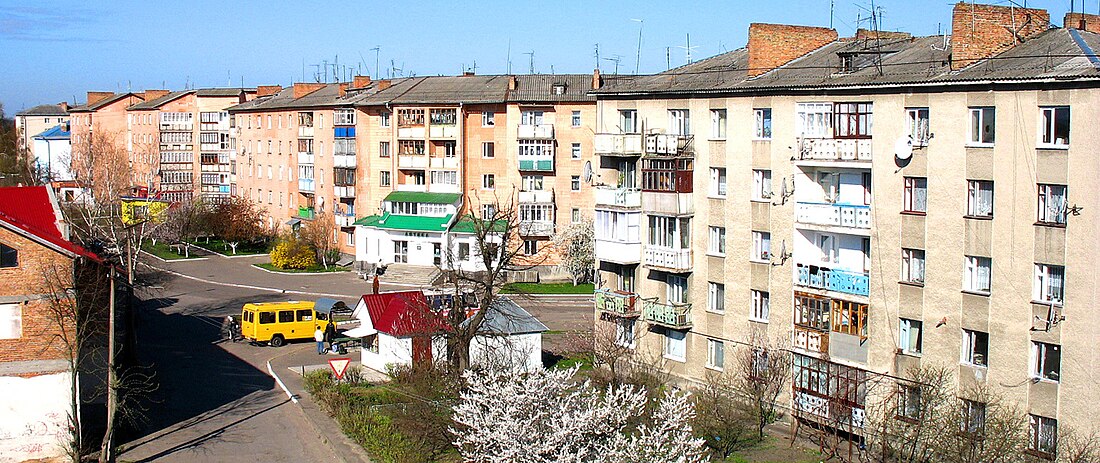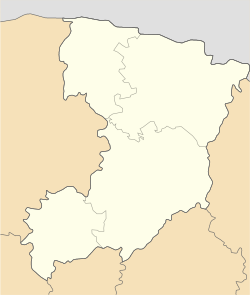Top Qs
Timeline
Chat
Perspective
Radyvyliv
City in Rivne Oblast, Ukraine From Wikipedia, the free encyclopedia
Remove ads
Radyvyliv (Ukrainian: Радивилів, IPA: [rɐdɪˈwɪl⁽ʲ⁾iu̯]; Russian: Радивилов, romanized: Radivilov; Polish: Radziwiłłów; Yiddish: ראדזיווילוב, romanized: Radzivilov) is a small city in Rivne Oblast (region) of western Ukraine. It was the administrative center of the former Radyvyliv Raion (district) until its dissolution in 2020, and is located south-west of the oblast capital, Rivne, near European route E40. The nearest larger cities are Dubno and Brody; the latter being 10 km (6 mi) away. In Soviet times, from 1939 to 1992, the city was known as Chervonoarmiisk (Ukrainian: Червоноармійськ, romanized: Červonoarmijs'k, Russian: Червоноармейск, romanized: Chervonoarmeysk). Population: 10,427 (2022 estimate).[1]
Remove ads
History
Summarize
Perspective
In the 14th century, together with whole Volhynia, Radyvyliv was annexed by the Grand Duchy of Lithuania. Following the 1569 Union of Lublin, the town was transferred to the Kingdom of Poland, where it remained for over 200 years. As a result of the Partitions of Poland, Radziwiłłow, as it was called, became a town of the Kremenetsky Uyezd in the Volhynian Governorate of the Russian Empire.
In the late 1800s, the Jewish population reached 4,000. Between World War I and the civil war between Ukrainian nationalists and Bolsheviks, the Jewish population declined to around 2,000.
During the January Uprising, a unit of Jozef Wysocki operated in the area of Radyvyliv. After World War I, the town returned to Poland, and was part of Dubno County, Volhynian Voivodeship. Its residents were Jewish (50%), Ukrainian (31%), and Polish (17%). During the Volhynian Genocide, ethnic Poles from villages in the area fled to the town, to escape Ukrainian nationalists. Almost all those who survived the slaughter left Radyvyliv, and settled in the People's Republic of Poland’s Recovered Territories.
Second World War and the Holocaust
In September 1939, at the onset of the Second World War, the town was occupied by Soviet forces. Some Jewish refugees who refused to accept Soviet citizenship were deported to the Soviet interior. The Wehrmacht's 6th Army occupied the town from June 1941 to March 1944. During the first days of the occupation, Jews were robbed by German and Ukrainian forces. On July 15, 1941, 27 Jews accused of communist activities were executed. The following day, Ukrainians organized a public burning of Jewish prayer books and other religious items.[2]
On August 15, all Jews were gathered in the marketplace while their homes were looted. A ghetto was established in April 1942 for the Jewish population of the town and surrounding villages, totaling 2,600 people. The ghetto's population was divided into "productive" and "unproductive" groups, with 400 and 2,200 Jews, respectively. Those classified as "productive" were forced into labor. Overcrowding and poor conditions led to widespread disease and hunger.[2]
On May 29, 1942, the section of the ghetto housing the "unproductive" Jews was surrounded by German forces, assisted by Ukrainian collaborators, in preparation for their murder. Those unable to walk were killed within the ghetto, while others were marched to a nearby area, forced to undress, and shot by machine guns. In total, 1,350 Jews were killed that day.[2]
A second Aktion took place on October 6, 1942. By then, ghetto residents were aware of the impending massacre, and about 500 Jews attempted to flee, although many were subsequently caught and killed. Approximately 950 Jews who remained in the ghetto were murdered. By the time the Red Army arrived in the summer of 1944, only 51 Jews from the town had survived.[2]
After the Second World War
Remove ads
Notable people
- Anton Kushnir (*1984) — Belarusian aerial skier of Ukrainian origin, was born here.
References
External links
Wikiwand - on
Seamless Wikipedia browsing. On steroids.
Remove ads






